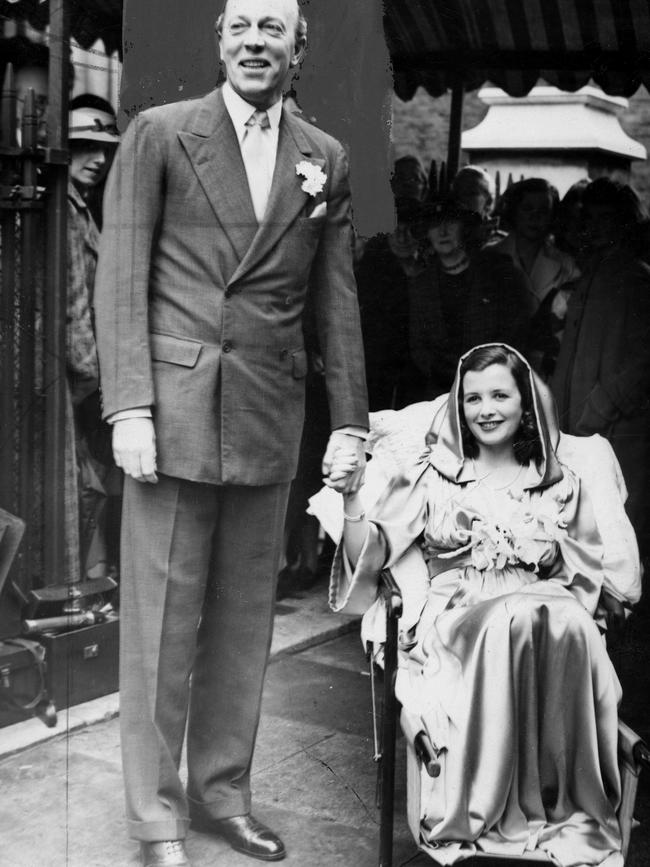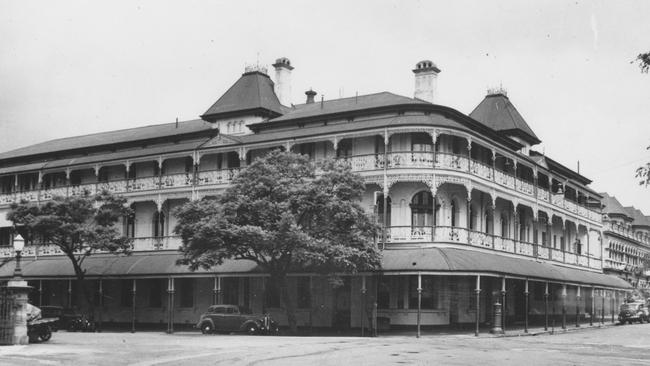Bodyline, Hollywood and the Bellevue beauty: forgotten star’s amazing life
Mary Maguire’s life began in pubs: soon Douglas Jardine and Ronald Reagan were in her orbit.
The Bellevue Hotel. Brisbane readers will remember it fondly, its destruction bitterly.
The Bellevue was beautiful, and it’s been 40 years since it was torn down by a company whose motto was “all we leave are memories”.
The memories: the Bellevue had a ballroom with maple panels and mirrored walls so guests could watch themselves waltz beneath crystal chandeliers. It had cast-iron balustrades and wraparound verandas; a garden with fig trees and jacarandas.
A barber attended each morning for the convenience of the guests. A waiter would meet arriving steamers.
These halcyon days have come to mind not because the anniversary of its midnight demolition looms — the Bellevue was brought to rubble, under police guard and at premier Joh Bjelke-Petersen’s command, in April 1979 — but because there’s a new book out, in part about a little girl who once lived there.
Mary Maguire. Probably you’ve forgotten her, if you’ve ever heard of her at all.
Mary, born Helene Teresa Maguire in Melbourne in 1919, was one of five girls who spent their teenage years at the Bellevue. Her parents — Mick, an ex-boxer with a cauliflower ear, and his ambitious wife Bina — wanted their daughters “to marry millionaires”.
Australia’s Sweetheart by screenwriter Michael Adams — he’s also the creator of the podcast Forgotten Australia — tells Mary’s story.
The Maguires were pub owners in Melbourne in the 1920s, but in 1933 they moved north to take over the Bellevue, mainly for the visitors’ book, which recorded such names as Dame Nellie Melba and Sir Arthur Conan Doyle.
From there they intended to launch their five daughters into Brisbane society.
The timing was auspicious: England’s cricket captain, Douglas Jardine, along with Harold Larwood, who just weeks earlier had fractured Bert Oldfield’s skull with a bouncer, had taken refuge at the Bellevue during the fourth Ashes Test of the Bodyline series.
Truly, they were the most hated men in Australia.

But they found friendship at the Bellevue. A reporter travelling with them said: “One of the reasons for us liking the Bellevue so much is the presence of the licensee, Mick Maguire, and his wife and their beautiful teenaged daughters.
“The girls were nubile beauties who used to race along the hotel verandas in the early morning rather scantily clad, shouting and giggling. It was said that Jardine took a shine to one of them.”
The daughter in question was Mary, then known by the pet name Peggy. She wasn’t yet 14.
The book recounts Australia’s Bill O’Reilly being surprised, upon joining England’s team for a Saturday evening dinner at the Bellevue, to find Peggy sitting beside Jardine at the head of the table, “and though there’s nothing to suggest this was anything more than a friendship, Jardine took such a liking to her that he gave her a gold watch”.
Peggy would later tell a gossip columnist she had been “that way” over an older man called Doug.

She was already a bit famous, having appeared in one of Australia’s first “talkies” as a child actress in Melbourne.
When producer Charles Chauvel — nephew of army general Sir Harry — announced his intention, in 1934, to hold a nationwide competition to find a girl of “feminine charm and loveliness” to cast in his new film, Peggy entered, and immediately won (some suspected she’d been chosen ahead of time, since they had already been introduced).
The film, Heritage, was hopelessly politically incorrect by today’s standards: Peggy’s character was required to die from an Aborigine-delivered spear wound in a burning homestead.
Ahead of the Sydney premiere, her face appeared on 100 billboards around the city. A Cobb & Co coach packed with people in period costume rattled through the streets, and men dressed as redcoat soldiers marched around the newly constructed Harbour Bridge.
Peggy’s performance wasn’t hugely admired, but Chauvel’s previous discovery, Errol Flynn, had upon moving to Hollywood signed a seven-year contract with Warner Bros.
Peggy’s parents decided it was worth a shot: she left Australia, with Mick as chaperone, in August 1936, sailing first-class on the Mariposa, having selected eight new frocks for the journey, and with enough stockings “that she would need to be a centipede to wear them all out”.
The lads from The Sun, The Truth and The Sydney Morning Herald were there to capture the moment: Peggy in her black fur coat, clutching a posy of flowers. In the copy she was described as “the most famous girl in Australia”.
On arrival in Hollywood, Peggy changed her name to Mary (alliteration was all the rage; think Greta Garbo). As Mary Maguire, she signed with Warner Bros and soon began hitting nightclubs such as the Trocadero so columnists could speculate about her love life, while also promoting films, none of which stands the test of time.
Before long she had a “case of shattered nerves”, which saw her admitted to hospital. Still, she remained a favourite of Hollywood’s women’s pages, demonstrating how she “buffed her creamy elbows” to keep them smooth, and walked with two books on her head to improve her posture.
There’s more to Mary’s life, some of it scandalous, some of it inexplicable: in 1939, aged just 20, she contracted tuberculosis and went through with a “wheelchair wedding” to a fascist and Nazi sympathiser, Robert Gordon-Canning, who was older even than her father. The five-year union almost certainly destroyed her career.
A child was born, and lost; there was a second marriage; a movie with Ronald Reagan; the death of her mother, which was announced in the Daily Mirror under the headline: “Champion Match-Maker Dies: She Married Off Five Pretty Girls” (one of whom would give birth to a boy who would eventually become Lord Wodehouse and Earl of Kimberley, although that’s a different sister and another story).
There is also Mary’s death as a penniless drunk, having “never achieved the critical or commercial success” that had seemed her destiny. Isn’t it funny how the past seems at times so distant, and yet so close behind?
Helene, who became Peggy, who became Mary Maguire, died on May 18, 1974, 40 years almost to the day after she was discovered by Charles Chauvel, but just five years before they pulled down the Bellevue.
And that was — can you believe it? — 40 years ago this year.
Australia’s Sweetheart, by Michael Adams, is published by Hachette Australia ($32.99).



